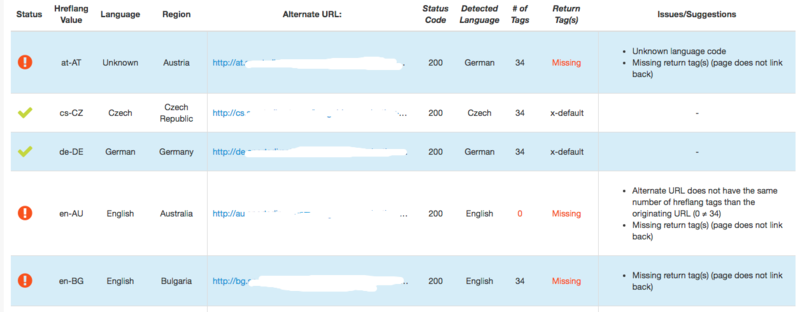Are HREFLang XML Site Maps Effective?
May 1, 2018HREFLang for Regional Sites
May 1, 2018Even Great HREFLang Implementations Have Problems
SEPTEMBER 06, 2016 BY BILL HUNT
At a recent Search Conference, a site was identified on Twitter as having a “Great Implementation of HREFLang tags” which just begs for someone to test it using an HREFLang Checking tool which I did.
The site is a large ecommerce site with 34 country versions, which is a decent size global site. I am blocking out the domain name out of respect to the person who gave the presentation who I have known for a number of years. Overall the implementation is really good with one specific error and two other issues that require review.
Issue #1 – Incorrect country or language codes
This is one of the most common problems I see with HREFLang tags. People just don’t invest the time to make sure they are correct which is why it always pays to use a tester to ensure compliance.

In the HREFLang element they are using at-AT but unfortunately, there is no AT language code. This is the Austrian site and the primary language in Austria is German. Looking at the page source code, the XML Language code it is set for which means the page is actually Germany German and not Austrian German. Note, this is the #1 reason why Google does not use this tag since most of them are wrong.
Issue #2 – Local Sites Not Mapping Back
When there are a lot of tags we often see one or more markets not linking back to the original page, which is the case on this site, and I identified three reasons:

Local site set incorrectly to x-default
Looking at the pages with the problem they had made the local page the x-default and mapped the local page to x-default rather to the actual global page.
For example, the Finnish site the page has 34 rows of HREFLang which is the correct number of alternate tags. However, the script they used mapped the Finnish page to the x-default as the 34th match and did not map back to the Global page which is set on the home page as the x-default page. Do you really want the Finnish page to be the default page or the global page? For more information on the correct use of x-default please view our guide.

Local Page Does Not have HREFLang Tags
In this case with Australia and also New Zealand these pages are missing all of the HREFLang tags. They are on the product pages but were not on the home page and seemed to be left off for some reason. The assumption is that they have cloned the site and using it for both countries so an error on one will generate an error on another.
Local Page is Missing
Some of the internal product pages had links to missing pages. These are either products not available in that market or for some reason they assumed the country had that page. While not an incorrect HREFLang implementation, mapping to the incorrect or broken page does reduce your crawl budget. This is a very common problem with dynamic settings especially using in page elements as they incorrectly assume you have that page for every country. This is one that we have added to our HREFLang XML Builder tool to map all of the pages and find missing pages.
Issue #3 – Too Many in page HREFLang Tags
In the screen capture from the session, it shows a lot of HREFLang tags. As mentioned above, there are 34 country sites represented meaning 34 lines of HTML embedded into the page. This IS a completely valid method to implement HREFLang but that is a lot of code to add to a page unnecessarily. We find that the HREFLang text is 4.08kb of the total HTML weight. Using another tool, we calculated the total HTML code is 31.5kb making the HREFLang tags nearly 13% of the overall HTML load of the page. That is a lot of extraneous code that can be shifted off the pages into XML site maps. We have some additional information on page weight increases caused by HREFLang attributes. http://help.hrefbuilder.com/support/solutions/articles/9000081109-too-many-hreflang-elements
Again a good implementation of the HREFLang but a few things to consider during the process to ensure that it is 100% correct to reduce the errors in Webmaster tools but more importantly allow it to correctly map the local pages.


